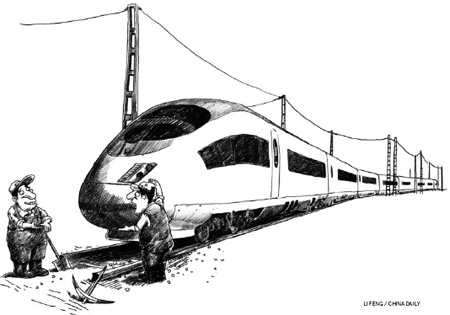-
-
China Daily E-paper
Op-Ed Contributors
Debate: High-speed rail
(China Daily)
Updated: 2010-04-19 08:04
 |
Large Medium Small |
With its extensive size and large population, the country is set to expand its railway network. Two experts give their views on the future of its high-speed rail.


John Scales: Combination of supportive features
China is engaged in the largest national railway expansion program since the 19th century. Part of this program will construct a high-speed passenger railway network that will become the largest in the world.
An important question is: How should plans for high-speed railways be viewed in the context of economic development? Even if high-speed railways in a developing country find a market of travelers willing and able to pay for the evident, personal benefits they derive from faster rail travel, this itself does not imply that there is developmental interest in this sector of the transport industry.
Indeed, if the question is considered in this light, it might be said that fast travel is luxury consumption. It is generally affordable only by those in developing countries who have by definition already raised themselves above the masses of the poor, who are rightly the focus of much of the world's development.
But is this narrow view justified? In the view of financial development institutions such as the World Bank, it is not. And it is certainly not a view that is applied when congested conventional roads are replaced by high-speed, high-quality expressways, where the consumption benefits of savings from travel time by higher-income, private car owners are routinely included in project appraisal methodologies.
A country's plans to build high-speed rail lines or even, as in China, a high-speed network, will inevitably affect the overall performance of its transport system, operationally, financially and environmentally. That performance is important in economic development.
In operational terms, a high-speed line will naturally provide faster speeds of travel for its users. But it may also free-up capacity on existing lines for other transport and affect interconnected modes, as well as alter both trip patterns and the relative use of different modes of transport. Fundamental changes in accessibility and mobility will influence national and regional economic development.
In financial terms, the decision to sink public investment into high-speed rail will inevitably divert resources from other public investments in transport infrastructure or from outside the transport sector. Moreover, the long-term financial sustainability of high-speed rail may be a serious issue for national budgets. Resource allocation and budget in transport are clearly important to economic development.
High-speed rail will also have various environmental and social consequences that may be negative or positive. Certainly, a high-speed passenger train will use more energy and generate more greenhouse gases than a slower passenger train over the same route. But if the higher speed attracts passengers away from road and air transport and, as in China, free up rail capacity for freight, it may reduce the overall long-term carbon intensity of the transport system. It will also reduce road accidents and avoid other externalities associated with private vehicle travel. For example, the International Union of Railways claims a high-speed train can carry eight times as many passengers as an airplane over a typical distance, using the same amount of energy and emitting one-quarter of the carbon dioxide for each passenger.
It follows then that the overall developmental benefits of high-speed rail can be neither asserted nor dismissed out of hand. Proposals need to be assessed on its merits.
To be successful, a new high-speed rail system needs to be built in corridors where railway capacity is already heavily utilized, indicating that new capacity is really needed. It must use management and engineering techniques that ensure capital and maintenance costs will not spiral out of the range of affordability and, crucially, with the right demand profile. This means sufficient numbers of people who can afford premium fares. A suitable corridor internationally may be one that connects two large cities 100-500 kilometers apart (Seoul-Busan, 420 km, Rome-Milan, 514 km, London-Paris 495km), but it may also be a longer corridor that has large cities located every 200 to 300 kilometers apart (Tokyo-Osaka 700 km, Beijing-Shanghai, 1,300 km and Beijing-Guangzhou, 2,100 km).
The combination of supportive features that exist on the eastern plains of China such as congested existing lines, high population density, rapidly growing disposable incomes and prevalence of many large cities in reasonable proximity to one another, are not all found in most developing countries. Most countries also do not enjoy the potential for a single-minded, collective effort and high production economies in system construction that arise when a government can commit the country, politically and economically, to a decades-long program over a vast land area. The factors that create supportive public investment programs come together in China in a way that is distinctly favorable to delivering an efficient, high-speed passenger rail network.
The author is the transport sector coordinator for the World Bank Office, Beijing. This article is excerpted from an upcoming report by the World Bank on high-speed rail.













